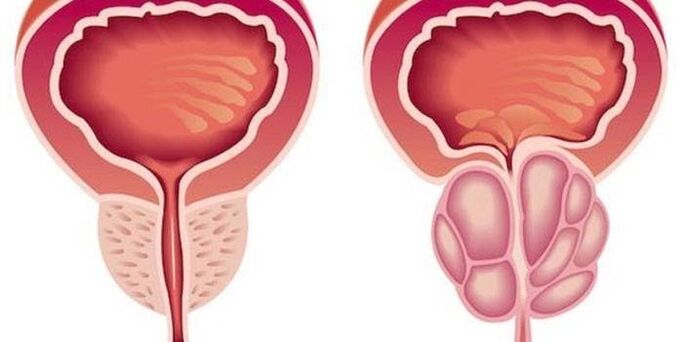The prostate gland can safely be called one of the most important organs of the reproductive system in men.The prostate is small, the size of a simple walnut, an iron that is located around the urethra.The main function of this body is the production of liquid prostate juice, which is actively involved in sperm formation and gives mobility to semen.

Prostate inflammation
According to the WHO, almost one -third of the male population diagnoses prostate disorders with subsequent complications.Prostatitis is a disease of the endocrine organ, characterized in medicine as an inflammation of the prostate, which resulted from damage to the tissues with viruses or bacteria.In addition, non -specific infectious pathology can develop against the background of inflammation of seminal bubbles, prostate appendages, or disorders of urination.
Signs of prostatitis
Conventional prostate disease is usually divided into several categories: bacterial, chronic and non -bacterial.In the first two cases, prostate disorders begin due to the fact that the bacteria penetrate the body.The acute bacterial form of prostatitis is accompanied by an increase in body temperature, severe pain in the inguinal part of the abdomen and perineum, spasms in the lower abdomen.A sick person starts to walk more often in the toilet, while sometimes the blood droplets come out with the urine.
The prostatitis of non -bacterial origin is found as a form of a pair of prostatic syndrome of chronic pelvic pain, while other symptoms may be completely absent.Chronic signs of prostatitis in men are expressed in pain during urination, in the groin, absence or disorder of sexual function.The peculiarity of this form of prostatitis is that most of the time it is asymptomatic.
It is worth noting that the characteristics of how prostatitis manifests cannot be characterized as permanent.Due to the fact that each organism is individual with certain signs, it can be completely absent and the disease can continue in different categories of men in its own way.Sometimes prostatitis begins with acute manifestations of the inflammatory process - then they speak of acute form.If the disease is only worried from time to time, then the most likely chronic stage of prostate inflammation.
The causes of prostatitis
Many different categories of citizens can be attributed to the risk group for such pathology, but more often prostatitis progresses in those who:
- sits a lot and moves a little;
- Prefers unbalanced nutrition of healthy foods;
- cannot get rid of addictions on drinking or smoking tobacco;
- often hypothermia;
- There is no permanent sexual partner;
- He often refuses sex.
However, even this is not a complete list of what prostatitis is.Doctors claim that prostate inflammation can even appear with an almost healthy man, in which case everyone often sipping with excessive fatigue, stress and poor ecology.It often progresses after surgery, severe bruising or other genital trauma.In any case, when even the less suspicion of prostatitis, it is worth a visit to the urologist.
Chronic prostatitis

The manifestations of the recurrent form of the disease are varied.For some men, this is a complete rejection of sex, a frequent desire for the toilet, itching or burning in the urethra or pain in the groin.In addition, another patient category may only experience such symptoms from time to time.Much more characteristic are the functional signs of chronic prostatitis, which are usually divided into three subgroups:
- Painful and honor impulse to the toilet, slowing down urination, the appearance of blood in phlegm, swelling in the groin, diarrhea;
- feeling of pressure in the anus during ejaculation, absence or weakness of erection, loss of desire to have sex, loss of acute orgasm;
- Feeling of anxiety, fatigue, depression, frequent nervous breakdowns and stress.
Recurrent prostatitis without proper treatment can not only cause a mass of problems, but also lead to serious consequences: adenoma, abscess and prostate cancer.Chronic prostate inflammation can continue, an unclear time, but the prostatitis course is never monotonous.Sharp, at times of high intensity, the attacks are replaced by periods of relative calm.
Catarrhaled prostatitis
Acute or parenchymal prostatitis in men is more common due to the weakening of immunity or infection entering the body.In this case, the catarrhal form of the disease can develop even after ordinary tonsillitis, acute respiratory viral infections and severe cough.Microbes, bacteria and other pathogenic microflora, along with the lymph, penetrate the prostate, where inflammatory processes are triggered.The first signs of prostatitis in men, as a rule, are a feeling of heaviness in the lower abdomen and a slight increase in temperature.
During a detailed examination, the doctor may notice other symptoms characteristic of the catarrhal form.For example:
- During the study, a slight edema of the prostate is revealed, while the patient procedure itself is extremely painful;
- Analysis of the secret from the prostate will detect the release of an increased number of leukocytes;
- Of ultrasound, purulent components, blocking or partial narrowing of the ducts through which the passages of urine are visible.
Prostatitis diagnosis
Thanks to active arousal and ubiquitous advertising today, even students know not only about the symptoms, but also how to treat prostate.However, the absence of any signs not only prevents the right medicines from being chosen, but also to diagnose on time.The best way to prevent inflammation is to visit the clinic more often.Therefore, as the diagnosis of prostatitis is often performed during a preventive examination by a urologist.
If there are complaints, an experienced doctor may already suspect prostate inflammation and prescribe the appropriate tests, among which they often perform:
- Rectal finger examination;
- Analysis of the secretion and fluid of the seeds;
- ultrasound prostate examination;
- urine and blood analysis;
- Taking a grease from the urethra.
How to treat prostatitis
How prostatitis and its treatment are manifested - the main topics for discussion in many international symposia and medical conferences.Scientists, ordinary doctors and experienced doctors are trying to identify more accurate symptoms of prostatitis each year to develop new drugs and prevention methods.At the moment, however, the classic spectrum of medical measures remains unchanged and includes:
- the appointment of antibacterial, antiviral drugs and immunomodulators;
- the use of magnetic fields, survivotherapy, ultrasound and laser treatment with respect to a diseased apparatus;
- The prostate massage course aimed at strengthening the reproductive functions of the body and normalizing the microcirculation of the blood flow in the genotian system.
Phito products are often used in complex treatment of prostatitis.

Treatment of chronic prostatitis in men
Alas, no method or medicine individually can save you from the manifestations of the disease and even more completely eliminate inflammation.Therefore, the treatment of chronic prostatitis is performed according to a complex regimen using effective tools of three groups:
- Antibiotics - fluoroquinolones.The preparations of this series penetrate well into the soft tissues of the prostate and destroy most types of harmful microorganisms.
- Non -steroidal anti -inflammatory tablets.Remove the prostate swelling, improve blood circulation, relieve pain.
- Alpha blockers.They help to relax the bladder and urethra, facilitate the leakage of urine.
In addition, drug therapy involves the use of a number of additional medicines that help to strengthen the prostate: vitamins, enzymes, candles, adaptogens.The doctor may also prescribe massage, simple physiotherapy procedures or arapeutic physical culture.All patients are prescribed by a special fiber diet, eliminating the use of alcohol, canned food, fried, too spicy or salty foods.































